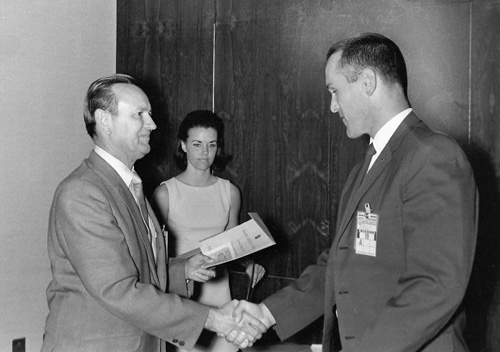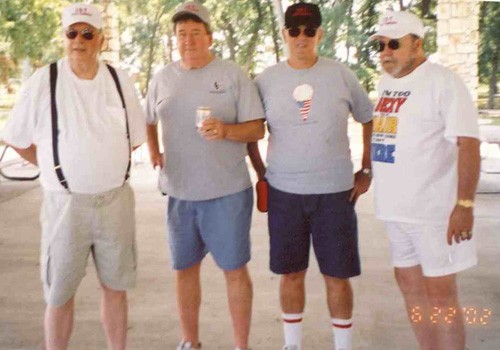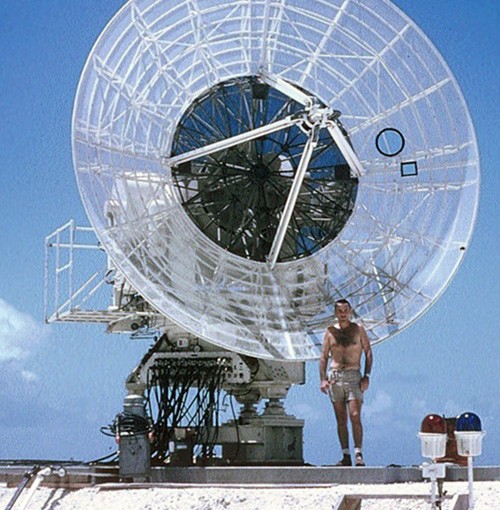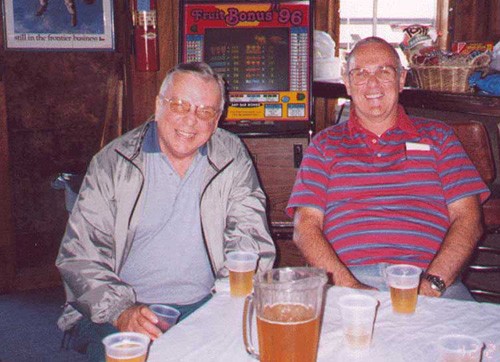|
Tom Sheehan (right) receiving a citation from Director of Flight Operations Chris Kraft – photo taken just before Apollo 10 (note the MCC mission badge). The citation was for support of Apollo 8. |
Tom Sheehan receives his Twenty-Five Year Service Award from Flight Directors Gerry Griffin (left) and Cliff Charlesworth. |
G’day mates,
I’m Tom Sheehan of Houston, Texas, USA. During the Apollo program I was the NASA head of the Instrumentation Support Team (IST), Track group. Our call sign was “Houston Track”, as many of you may recall. All other members of the group (except for one) were Philco troops under the able leadership of George T. (Tom) Williams.
Many of us still reside in the Houston area. (I can throw rocks out of my back door into the NASA property.) These include the aforementioned Tom Williams, Robby Robertson, Eddie Pickett, John Blackburn, and Don Halter.
A decade or so ago,
some of this group (at the urging of Robby) formed the august organization
now known as the “Instrumentation Support Team – Old Timers”.
(How original is that?) Of course we’ve included other IST positions:
Telemetry, Command, Air/Ground Voice, etc. (We needed more people to shout
for rounds, since we do drink a little beer at our monthly meetings.)
|
Tom (GT) Williams, Eddie Picket, Tom Sheehan, Robby Robertson. |
Most of the troops served in one of the USA military services in various technical fields. Many then worked for the original field engineering organization; Philco Technical Representatives Division (TechRep). Some worked for similar organizations such as RCA Service Company. Almost all worked on various USA satellite, missile or aircraft test ranges.
My path was more or less typical. After service in the US Navy, I was a civil service site supervisor on a FPS-16 radar station of the USN Pacific Missile Range.
Next, I was recruited by the
RCA Missile & Surface Radar Division (manufacturer of the FPS-16, MPS-25,
FPQ-6, BMEWS and other radars) as a field engineer.
|
Tom Sheehan on Johnson Atoll, with an MPS-25 radar antenna at (probably in 1962) when he worked for RCA, Missile and Surface Radar Division. |
After a few years of traveling
around the world to the many instrumentation radar sites (including Carnarvon
and Woomera,
Australia), I wanted to be a part of the “space biz”. I turned down
an offer from Collins Radio to be a part of their Unified S-band team and
went to work for NASA at the Goddard Space Flight Center (GSFC). From Gemini
VI through XII, I deployed to the Mission Control Center (MCC) in Houston
as part of a multi-agency Network Support Team (NST) during flights.
For Apollo, the powers-that-be decided that a permanent Instrumentation Support Team would be resident at the MCC. Since Philco built and ran the MCC for NASA, their employees would provide the team members. Each group would have a NASA group head (and I transferred to Houston), but direct management was Philco. Mostly this arrangement worked! The dual management of the network between GSFC (the network owners) and Houston (the users) proved interesting, but we also made that work.
Enough of that stuff. Mike Dinn asked
for some input to Canberra’s Apollo 11 anniversary celebration. When
you are old and retired, it is impossible to think about
one particular “good, old day” without opening the flood-gate of
recollections and all the errors and gaps that come with that process.
Unfortunately, my personal recollection of Apollo 11 is that it was anti-climatic. Exciting, spectacular and wonderful; but anti-climatic. By then, the team (most certainly including all of you) was composed of “palos techtis” (roughly, old pros). There was no doubt that Eagle would land; unless we had a three-sigma bad day. My most profound memories are of Apollo 8, and so:
Disclaimer
The following narrative is almost totally
based on memory for the following reasons:
I’m a lousy historian.
What records that I may have are buried somewhere.
Apollo 8
As everyone probably recalls, Apollo 8 became a lunar-orbital mission while we were deep into the Apollo 7 planning and simulation activities. By the time planning for Apollo 8 filtered down to my level, I let my deputy, USAF Captain Rod Reining, continue with the daily whipping of the Apollo 7 trackers and I went off to have fun.
The gutsy decision to go lunar for Apollo 8 came at a time when lunar trajectory capabilities resided only in the off-line Mission Planning and Analysis Division (MPAD) computers & software. Many procedures for MCC’s lunar mission operations were in an equal state of un-readiness.
Even worse, we had no mechanisms for assimilating the lunar operational expertise from our colleagues at JPL.
We had a few people in MPAD that had either worked with/for JPL or associated contractors. Bill Wollenhaupt, for example, had worked on the Lunar Orbiter Project and was the Houston guru of MassCons. Given that we knew how to do earth orbit operations and that the 26 meter stations were prime for cislunar and lunar ops, coverage by these sites became our focus.
Once MPAD had a reasonable trajectory established, I requested look-angle data for (at least) these stations. Having some understanding of stations being located in valleys, but not having a clue as to line-of-sight rise-rate, I asked for a 1 sample per 10 second printout. A courier showed up at my office door with a handcart and 5 or 6 full boxes of computer paper. Talk about lessons learned!
At some point in this exercise, a distinct lack of overlap in coverage between
Honeysuckle Creek and Madrid got our attention. Our Goddard Space Flight Center
(GSFC) counterparts were up to their ears with reference geoids, inter-center
trajectory coordination, acquisition data formats, etc. and were not very
interested in working “terrain masking” issues. I’m not certain
when we finally began conversations with the real experts; ie. the stations.
I do know that Honeysuckle and Tidbinbilla personnel taught us as much about
that subject as we could handle!
Since we were not yet ready to send out acquisition data, we had to get raw masking data from the stations, examine the printouts for AOS/LOS data and send this info back to the stations for verification. This activity confirmed our concern over uplink handovers and left me with a problem of convincing our management that this was a real problem. Our Real Time Computer Complex (RTCC) station-characteristics implementation had provisions for reflecting keyholes (both east/west and north/south) but nothing else. IBM’s first response to a request for masking implementation stated a two-year lead-time. After a battle fought all the way to (at least) our directorate chief, I think it happened by Apollo 10. In the interim, we forced acq data for the 26 meter stations and asked for a report of AOS/LOS times, etc.
As soon as Apollo 7 flew (and we survived our first splashdown party in two years), we began ‘integrated’ simulations for Apollo 8. The crew had been training for some time in the “standalone” configuration. We focused on key events such as launch, trans-lunar injection (TLI), lunar orbit injection (LOI), etc., so we still did not get much of a feel for long-duration station view periods or handovers. We did enough lunar orbit sims, however, to understand that phase.
As Eddie Pickett said, “We sim’d Christmas 47 times before we actually had it.”
When launch time came, the whole team was excited about the mission, but nervous about the “real world”. We had already learned enough about the limitations of our simulated network to be concerned. After all, those hard-working troops didn’t know any more than we did about operations beyond earth orbit! And the limited Network Simulations, conducted by our GSFC cohorts, did not provide much opportunity for interaction with the stations. But by December 21, 1968 we were “GO FOR LAUNCH”.
Everyone held their breath during the first manned
flight of the Saturn V, but it was perfect. Werner von Braun’s team deserved
all the praise they received. TLI came quickly, the SIVB did its thing and
we were off to the races. Then we began to learn about trans-lunar operations
for real!
This may be a good point to digress and discuss the operations of the Mission
Control Center (MCC) Instrumentation Support Team (IST); particularly
HOUSTON TRACK.
While the Telemetry Instrumentation Controller (TIC) and the Real Time Command (RTC) controller worked for all of the Flight Controller positions, Track was primarily part of the Flight Dynamics Officer (FDO) team.
Other members of this team directly concerned with trajectory operations included the Real Time Computer Complex (RTCC) Data Select and a group of space navigation experts called Select Support. This position was mainly concerned with recommending tracking station geometry and related matters, during cis-lunar and lunar orbit operations; particularly for the two-way stations.
Track’s other foot was in another Flight Controller sandbox –
During early Apollo missions (including Apollo 8) this was the Procedures position and for later missions it was the Integrated Communications Officer (INCO). Track’s role of coordinating and publishing the pre-mission Instrumentation Support Plan (ISP) and the Site Configuration Messages (SCM) during the missions was the source of much conflict between Track’s multiple roles. The initial hack at an ISP usually was no problem, but once integrated simulations started, issues arose concerning AOS activities (go-for-command versus ranging, etc.), uplink handovers and many others. Most of these issues were then re-visited during flight; again and again.
As I said before, learning to operate, (particularly
with the real world) during cislunar and lunar orbit was a major step for
Houston. Apollo 8 was the most benign lunar mission that we could fly and
that allowed us to learn to walk before we had to fly.
Back to Apollo 8.
Our first surprise after trans-lunar injection (TLI), came from Goddard Space Flight Center (GSFC). It seems that all of the teletype tracking data at one sample per __ seconds exceeded the GSFC communications processor’s blocking algorithm (for transmission to the MCC on the wide-band interface) and was backing up. The GSFC Communications Manager’s initial response was to “skip-off” backed up data. This solved his problem, but Select Support, Data Select and finally FDO screamed about batch discontinuities in the tracking data affecting trajectory processing. I think that we lived with this for Apollo 8 using some operational workarounds. The ultimate fix was to reduce the sample rate of the data from the network, but I can’t remember when that was implemented.
Sometime during lunar orbit insertion (LOI) sims, we learned the hard way that failure to burn LOI would result in an early AOS. The obvious solution was to have the prime station monitor the AOS point early. Since the MCC could not generate acq data for multiple points, GSFC suggested that they would generate “lunar leading-edge” acq data. I’m not sure exactly when this plan devolved into a truly laughable communications snafu, but it did. One person’s “lunar leading-edge” is another person’s trailing edge. It all depends on whether you are talking about the moon’s orbital path around earth or the apparent lunar path as observed from earth. Some of you folks, better grounded in planetary operations, probably thought that we (and GSFC) had our heads where the sun doesn’t shine!
The trans-lunar CSM barbecue maneuver called passive thermal control (PTC) worked well, but caused some LOS’s that seemed to come just when trajectory operations had a good “super-batch” for update. Of course, Track caught the wrath of Select Support, Data Select and FDO for events beyond our control. Trackers became hard-shell tortoises in a hurry! And not a diplomat in the crowd!
By the time for LOI, MCC operations had settled
down to a dull roar. That changed forever when we heard
the crew’s description of the lunarscape and even more so when we
saw that fantastic earth rise with the lunar limb in view. My all-time favorite
photo.
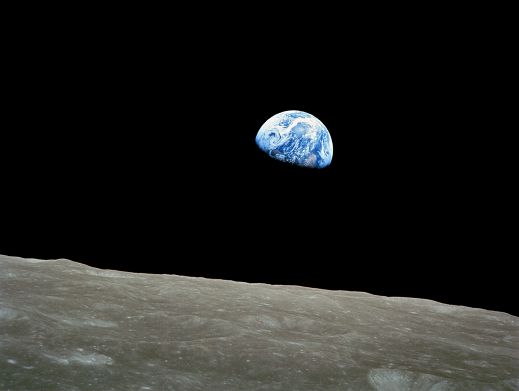 |
|
Earthrise from Apollo 8. |
Hardly anyone left MCC for very long during lunar orbit. There was a universal
feeling of awe and fulfillment. All too soon, it was time for TEI and the
trip home.
Another of Track’s ancillary functions was selecting test support positions (TSP) for the reentry tracking ships and getting pointing data to them. I believe Apollo 8 was so nominal that the pre-mission TSP was used. However, one of the later missions resulted in another memorable snafu. Weather caused a change in splashdown location. I selected several TSP’s and had look-angles generated to select the best TSP. Within minutes of sending that TSP to one of the ships, we received a rather curt message from the ship’s master saying that he couldn’t get there from his present location unless he could fly. It seems that there was a reef or shoal in the way; one that did not show on our charts.
As I recall, the Apollo 8 splashdown party was pretty tame and abbreviated. Probably due to the holiday season, but the emotional letdown may have entered into it also. When the formal crew debriefings were over sometime in January, we had the traditional crew & flight control team informal debriefing. This is AKA a rip-roaring beer-bust at the long-since-gone Hauf Brau Garten. We made up for any shortcomings of the earlier party.
And so my friends/compatriots/teammates, I’ll conclude this rambling trip through personal memories of a highlight of my career. Perhaps I’ve given you some appreciation of why I consider Apollo 8 so significant. With it, we learned many valuable lessons and established a solid foundation for future lunar missions. Without it, we would have had to drink from the proverbial fire-hose and maybe not have been so successful.
At the beginning, I said that I was neither a historian nor a good record-keeper. However, I did not expect that to result in so many unremembered details. And probably as many errors. However, I do not intend to revise this treatise unless there are some really egregious mistakes that affect the understanding. On the other hand, I invite your comments and questions and will certainly prepare an addendum.
Always proud to have been a Houston Track,
Tom Sheehan
CHEERS!
|
Walt Hrab (TIC) and Tom Sheehan, at The Outpost, 2002. |
In loving memory of Tom Sheehan, 1936 – 2021.
